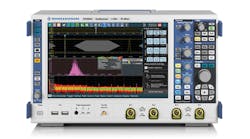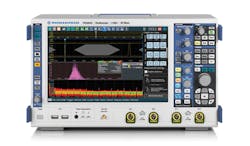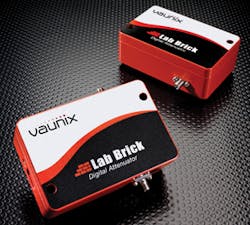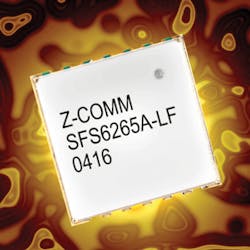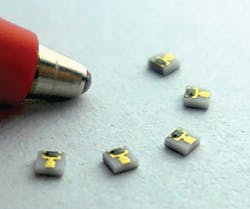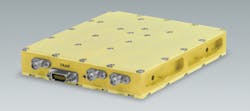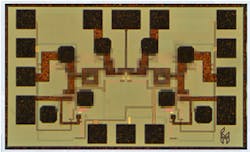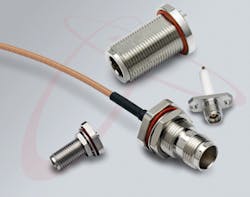This file type includes high-resolution graphics and schematics when applicable.
Thousands of engineers from the RF/microwave industry will once again gather at this year’s IEEE’s annual International Microwave Symposium (IMS) and Exhibition. They get to indulge in a healthy diet of high-frequency technology on the symposium side and a broad range of products on the exhibition side, from the smallest semiconductors and integrated circuits (ICs) to complete systems and test instruments. It offers a chance for designers to complete a bill of materials (BOM) for a new circuit, or track down the test equipment needed for the new wing of a manufacturing facility—or to simply catch up with old friends and competitors.
The IMS 2016 Exhibition is scheduled for May 24-26, 2016 in the Moscone Center, San Francisco, Calif. (Go to the IMS 2016 website for a complete exhibitors’ list and exhibition floor plan.) Over 600 companies are planning to exhibit, providing visitors with a chance to “wander the aisles” in search of a particular product or browse and learn about the latest product offerings from this diverse group of electronic hardware and software manufacturers. Attendees can compare products and performance levels in real time, without a computer or the Internet, moving from booth to booth and meeting representatives from each company in quest of a spectrum analyzer with a particular frequency range and analysis bandwidth or an oscillator with unbeatably low phase noise.
For example, want to know more about the latest gallium-nitride (GaN) discrete transistors or ICs? Numerous suppliers will be available to discuss the merits of this popular high-frequency, high-power semiconductor technology, and vendors will be on hand to compare power amplifiers (PAs) and offer details about their own GaN products (see "GaN Breaks Through Performance Barriers" for more on GaN, and "Small Cells Help Keep 5G Connected" for more on new GaN products from Qorvo, Booth 839). Similarly, for a hands-on demonstration of the versatile new Universal Serial Bus (USB) spectrum analyzers from Tektronix (see "Analyzers Squeeze Real-Time Power into Portable Packages"), time at Booth 2449 will be well spent.
Many manufacturers use the annual IMS Exhibition as a launching point for a new product. For instance, Keysight Technologies (Booth 1239), which earlier in the year had expanded its UXA series of signal analyzers for coverage from 3 Hz to 50 GHz (see "New-Look Analyzers Scour Bandwidths from 3 Hz to 50 GHz"), plans to introduce an innovative new family of device current analyzers—the company’s first such product line (see “Analyzers Measure Device Microcurrents").
Test Measures Up at IMS
The exhibition will be a showcase for many of this industry’s leading test-and-measurement equipment developers. Anritsu Co. (Booth 949) tackles remote spectrum monitoring with a family of portable, modular spectrum analyzers, including the model MS27101A (Fig. 1). The instruments are very much the image of modern high-frequency test equipment, in compact, modular form, working with optional Vision software on a Microsoft-Windows-compatible personal computer (PC) and the computer’s display screen via a USB connection. It integrates a web server that allows access anywhere in the world via Internet browser for truly remote, off-site monitoring.
They can be used to find and identify interference signals, helping wireless-network operators eliminate communications-systems problems. Given the growth of wireless services, including the growing wave of wireless Internet of Things (IoT) devices in the vicinity of wireless networks, remote spectrum monitoring helps locate unlicensed or interfering signals at sweep rates to 24 GHz/s. The IP67-rated instrument is housed in a half-rack enclosure and designed for outdoor use. It operates on a mere 11 W of power, enabling it to be powered by solar cells in remote applications. Three or more units can be used together to triangulate the location of an interference signal.
Boonton Electronics (Booth 1830) will show its RF power meters/sensors and modulation analyzers, including the completely redesigned model 4500B peak power analyzer. It works with different sensors for peak power measurements from 1 MHz to 40 GHz. Depending on the choice of sensor, the 4500B can deliver a 70-dB power measurement range, reading pulsed signal levels from –50 to +20 dBm and modulated signal levels from –60 to +20 dBm.
The analyzer provides a video bandwidth of 65 MHz with better than 7-ns risetime. It can measure the power levels of pulses as narrow as 6 ns and at pulse repetition frequencies (PRFs) to 50 MHz. And to view the statistical analysis, a 8.4-in. thin-film-transistor (TFT) color liquid-crystal-display (LCD) screen shows as many as four measurement channels, two memory channels, and one math channel simultaneously.
Maury Microwave Corp. (Booth 1139) provides high-accuracy hardware and software tools for performing various noise-parameter and load-pull measurements through microwave and millimeter-wave frequencies. For example, the firm’s MT97x and MT98x series automated impedance and load-pull tuners, respectively, are based on slide-screw designs. With that design, they can position a slab-line transmission structure so that it will precisely match a device under test (DUT) to a terminal impedance. These tuners have long been essential tools in measuring and modeling active devices, especially for optimum performance at high-power and low-noise-figure levels. The firm also offers a series of software tools for the automated control of these PC-based tuners.
National Instruments (Booth 1529), in addition to demonstrating its popular LabVIEW test software, will showcase many of its modular test instruments, including power meters, signal generators, and vector network analyzers, and vector signal analyzers (VSAs). These feature PXI Express (PXIe) modules operating from 20 Hz to as high as 26.5 GHz, and instantaneous bandwidths as wide as 320 MHz for frequencies to 3.6 GHz and to 765 MHz for frequencies above 3.6 GHz. The modular approach makes it possible to pack multiple measurement functions, such as signal generation and analysis, into the space normally taken in an equipment rack by single-function instruments.
Specifically, the Ni PXIe-5668R combination VSA and spectrum analyzer is available in versions operating from 20 Hz to 14.0 or 26.5 GHz with 765-MHz analysis bandwidth. It features –129 dBc/Hz phase noise offset 10 kHz from an 800-MHz carrier and –168 dBm/Hz average noise floor at 1 GHz. The instrument digitizes input signals at 2 Gsamples/s and 12-b resolution.
Rohde & Schwarz (Booth 1827) will also exhibit its radio-monitoring test gear, including the R&S UMS12-OEM Monitoring System, a modular test system capable of monitoring signals from 100 kHz to 6 GHz. The system, which can be powered by ac or dc sources, will readily integrate into vehicular test systems for mobile spectrum monitoring and interference direction finding. It employs an open programming interface for operating flexibility, and is ruggedly constructed for use in outdoor environments. The system, which includes AM and FM demodulators, offers 1-Hz tuning resolution and two female Type N connector input ports for antennas.
Furthermore, the firm will show its latest high-performance oscilloscope—the model RTO2000 laboratory scope (Fig. 2)—that’s able to display correlations between time and frequency via analog input channels and advanced digital signal processing. A new zone trigger permits graphical separation of events in the time and frequency domains, defining as many as eight zones on screen and activating a trigger signal when a signal either does or does not intersect the zone. This can greatly simplify the most challenging measurements, such as searching for EMI disturbances in a circuit.
The instrument captures 1 million waveforms per second and operates at rates to 20 Gsamples/s with as much as 16-b vertical resolution to capture the most intermittent signals for display on a 12.1-in. capacitive touchscreen. Users can view all saved signals and analyze them with tools such as zoom, measurement, math, and spectrum-analysis functions. The oscilloscope comes in two- and four-channel versions with bandwidths of 0.6, 1.0, 2.0, 3.0, and 4.0 GHz.
Roos Instruments (Booth 2452) will display examples of its automatic-test-equipment (ATE) hardware and software, including its Cassini configurable instrument system with its capability of holding multiple instruments and measurement functions in a tight space. The ATE system is available for a number of different test applications, including for characterizing power amplifiers, third-generation (3G) cellular communications devices, base stations, backhaul equipment, and even devices for millimeter-wave automotive radar systems. For example, the automotive test system is available for testing at 40 and 77 GHz with full S-parameter coverage and for automated testing of key component parameters, such as fixed output power, efficiency, leakage current, and third-order intermodulation (IM3).
Teledyne LeCroy (Booth 1739), just one of a number of Teledyne companies at IMS, will exhibit its high-performance LabMaster 10-100Zi 100-GHz-bandwidth oscilloscope. With a 240-Gsamples/s real-time sampling rate, the instrument is able to detect short-duration transient signal events occurring over extremely wide bandwidths from 20 to 100 GHz.
An Accessory to Test
In addition to the many attention-grabbing test instruments at IMS 2016, the exhibition floor will include a generous sampling of test accessories for making RF/microwave measurements, including the “Lab Brick” line of programmable attenuators from Vaunix Technology Corp. (Booth 523). The model LDA-023 programmable attenuator (Fig. 3) will target applications from dc to 20 GHz. Supplied with graphical-user-interface (GUI) to run on a PC or in a system with a self-powered USB hub, the attenuator’s range spans 0 to 63 dB, controllable in 0.5-dB steps. With a response time of 100 ns, very little time will be wasted changing signal power levels in a test system.
AR RF/Microwave Instrumentation (Booth 1711) will display some of its high-power amplifiers for assisting with EMC/EMI testing, including the classic 16,000A225. This self-contained, solid-state amplifier, which pumps out 16,000 W CW power from 10 kHz to 225 MHz, uses liquid cooling to dissipate heat from the active devices and maintain excellent long-term reliability. The amplifier can be controlled locally or under remote GPIB or RS-232 control for use in ATE systems.
Featuring one of the more diverse product lines in the industry, Mini-Circuits (Booth 2029), will show a healthy cross-section of its wares at 2016 IMS. The model PMA3-83LN+ low-noise amplifier (LNA), for instance, has a noise figure of 2 dB or less from 0.5 to 8.0 GHz, and provides generous 21-dB gain within a 3.00- × 3.00- × 0.89-mm, 12-lead MCLP.
In addition to its families of compact RF/microwave active and passive components, Mini-Circuits will display larger components well-suited for test-and-measurement applications, including programmable attenuators that handle 1 MHz to 8 GHz. Ideal for use in path-fade simulators and ATE systems, the attenuators provide attenuation values from 0 to 120 dB in 0.25-dB steps under computer control using RS-232, Ethernet, or USB interface.
The firm will also show its lines of USB- and Ethernet-controlled synthesized signal generators for use from 0.25 MHz to 6.4 GHz. These compact, modular test signal sources include the model SSG-6400HS with frequency range from 0.25 to 6400 MHz and output-power range of –75 to +10 dBm. For more versatile testing, the synthesizer also provides amplitude modulation (AM), frequency modulation (FM), pulse modulation, and phase modulation along with frequency-sweep and frequency-hopping capabilities.
Mini-Circuits will spotlight its growing numbers of test products, including the ZTM Series of modular test systems that fit different function modules into a 19-in. rack-mount chassis. These are typically analog signal-processing functions, such as switches and attenuators that can operate under USB or Ethernet control. Test functions include switches to 18 GHz qualified to 100 million switching operations. The firm will customize a signal-routing and attenuation solution and meet a customer’s requirements within short order.
L3 Narda-MITEQ (Booth 1811), which represents the joining of two of the industry’s most long-running and influential companies, will showcase its many active and passive component solutions. They include the recently introduced model 4792 variable attenuator for applications from 8 to 18 GHz. Part of a family of variable attenuators with different coaxial connectors that covers 0.8 to 18.0 GHz, the 4792 is equipped with female SMA connectors and provides as much as 30-dB attenuation with only 0.5-dB insertion loss and attenuation flatness of ±0.5 dB. It handles 5 W average power and 3 kW peak power in a compact enclosure.
Serving Up Signals
For those in need of stable signal sources, Synergy Microwave Corp. (Booth 1615) has an array of free-running and phase-locked options. High-performance oscillators and frequency synthesizers on display at the company’s booth will be the recently introduced model DXO10701095-5 surface-mount VCO for X-band use from 10.5 to 11.0 GHz. It tunes across its 500-MHz bandwidth by means of 0.5 to 15.0 V and draws 25-mA maximum current from a +5-V dc supply. The VCO delivers at least +2-dBm output power with low phase noise of –82 dBc/Hz offset 10 kHz from the carrier. The miniature VCO is ideal for satellite-communications (satcom) systems, since it measures just 0.3 × 0.3 × 0.1 in.
In addition to its passive components, Synergy will show its award-winning combination of a phase-locked oscillator (PLO) and frequency synthesizer (a Microwaves & RF “Top Product of 2015”), a frequency source with a proprietary application-specific integrated circuit (ASIC) for wideband frequency tuning from 100 MHz to 15 GHz. The microwave source achieves outstanding phase noise of –118 dBc/Hz offset 1 kHz from the carrier and –123 dBc/Hz offset 10 kHz from the carrier.
Vectron International (Booth 1028) will feature some of its latest stable oscillators, including oven-controlled crystal oscillator (OCXO) model OX-208 for use at frequencies from 5 to 20 MHz. Supplied in a surface-mount package measuring just 25.4 × 25.4 × 12.7 mm, the OCXO boasts temperature stability of ±0.4 ppb from 0 to +70°C and ±0.8 ppb from –40 to +85°C. With phase noise of –155 dBc/Hz offset 10 kHz from the carrier and aging rate of 0.15 ppb/day, it is a good fit for frequency synthesizers, military communications equipment, and test equipment.
Bliley Technologies (Booth 1548), an exhibitor at the recent Satellite 2016 conference and exhibition, supplies low-noise oscillators for space and military applications. The firm “made noise” at the Satellite 2016 show with its new Apollo series of miniature OCXOs, which are also sure to capture lots of attention at IMS. Measuring just 26.16 × 26.16 × 11.68 mm and with standard frequency of 100 MHz and +10 dBm or more output power, these sine-wave sources are available for factory-set frequencies from 30 to 130 MHz. Initial frequency accuracy is ±0.25 ppm. The OCXOs exhibit worst-case harmonics of –30 dBc and worst-case spurious content of –80 dBc. Worst-case aging is ±5.0 ppb/day. These extremely well characterized sources have a number of options for phase noise, and available performance is as good as –172 dBc/Hz offset 10 kHz from the carrier.
Crystek Corp. (Booth 1733) will demonstrate some of its latest high-frequency sources, including the recently announced model CVCO55CC-2275-2290 coaxial resonator oscillator (CRO) for tuning signals from 2275 to 2290 MHz. It tunes that range by means of +0.5 to +4.5 V dc and provides signal output levels of +4.5 dBm (typ.) with ±2.5-dB flatness (typ.). Typical phase noise is –115 dBc/Hz offset 10 kHz from the carrier, while second harmonics are –25 dBc (typ.). In its surface-mount package, the CRO measures just 0.5 × 0.5 in.
(Booth 711) will offer visitors a look at its lines of miniature frequency sources, such as the model SFS6265A-LF fixed-frequency synthesizer for C-band use at 6265 MHz. The low-cost, PLL-based source (Fig. 4) works with an external 100-MHz reference oscillator to achieve –89 dBc/Hz phase noise offset 1 kHz from the carrier and –90 dBc/Hz phase noise offset 10 kHz from the carrier (second harmonics and spurious suppression are –20 dBc and –65 dBc, respectively). The synthesizer operates at temperatures from –40 to +85°C and is well-suited for radar applications. Based on a VCO running at +5 V dc and 35 mA, it is capable of +3-dBm typical output power. Its RoHS-compliant, surface-mount housing measures a mere 0.6 × 0.6 × 0.13 in.
For higher-frequency signal sources, Micro Lambda Wireless (Booth 1110) will present examples of its YIG-oscillator-based devices, such as the MLMS Series of miniature frequency synthesizers for applications from 500 MHz to 16 GHz. Available in standard frequency bands of 0.6 to 2.5 GHz, 2 to 8 GHz, 6 to 13 GHz, and 8 to 16 GHz, these low-noise synthesizers provide output levels from +10 to +13 dBm and programmable 1-kHz tuning steps. They can be equipped with a five-wire SPI or USB control interface and with internal crystal oscillator reference, external crystal oscillator reference, or both. The miniature sources measure 2.5 × 2.5 × 0.5 or 0.65 in. and suit single-slot PXI chassis.
Construction Materials
Visitors to the 2016 IMS exhibition hall will also find the electronic materials they need that are essential to electronic design, including those for electromagnetic-compatibility (EMC) shielding and printed-circuit boards (PCBs). Engineers from Rogers Corp. (Booth 2039) will be on hand to discuss circuit materials and how different material parameters relate to the final performance of RF/microwave circuits.
The Rogers’ booth will feature examples of the company’s many high-quality circuit laminates, including its popular RO4000 hydrocarbon ceramic laminate materials for use at microwave frequencies. These materials can be processed much like low-cost FR-4 circuit boards without need of special processing steps like polytetrafluoroethylene (PTFE) circuit materials, and yet still deliver low loss at high frequencies plus outstanding stability with temperature.
For applications requiring extremely low insertion loss, the company also offers LoFoil conductive foil with the RO4000 dielectric materials; the smooth copper surfaces assist in forming low-loss circuits and high-frequency transmission lines such as microstrip, stripline, and coplanar waveguide. Rogers offers a range of RO4000 material configurations, including RO4350B laminates that employ RoHS-compliant, flame-retardant technology for applications requiring UL-94V-0 certification.
Taconic (Booth 1511) and the firm’s Advanced Dielectric Div. will be exhibiting its laminate materials for high-frequency analog and high-speed digital circuits. The firm will offer its low-loss, ceramic-filled PTFE laminates and woven-glass-reinforced PTFE laminates in a range of dielectric-constant values to accommodate a wide range of frequencies and transmission-line circuits. In addition, Taconic will show a sampling of its specialty materials, including fastfilm flexible thin-film RF material.
Crane Polyflon (Booth 915) will present its PTFE-based circuit-board materials, including the popular CuFlon microwave substrates. The firm uses a proprietary plating process to create laminates with low-loss characteristics and outstanding dielectric strength. The material exhibits a dielectric constant of 2.05 at 18 GHz in the z-axis (thickness), held to a tolerance of ±0.05.
Passive but Powerful
Weinschel Associates (Booth 2214), one of the longest-running developers and suppliers of high-quality passive components, will show its many product lines at IMS 2016. These include power dividers/combiners, terminations, dc blocks and, perhaps the components the company is best known for, attenuators, both fixed and variable. Fixed attenuators are available as individual units or in calibrated sets for test and measurement applications, and for low-, medium-, and high-power applications.
As an example, model WA35 is a rugged coaxial attenuator with customer-specified attenuation values from 10 to 40 dB that is usable at 5 GHz. It comes with Type N or DIN connectors and can handle 300 W average power and 10 kW peak power (for a 5-µs pulse). The attenuation accuracy of these high-power components is ±0.75 dB for attenuation values of 10 through 30 dB and ±1 dB for 40-dB attenuation.
MECA Electronics (Booth 818) will be one of many small but capable engineering firms at the exhibition with high-performance passive components. On display will be low-distortion terminations and attenuators as well as the latest addition to its N-way power dividers, with weatherproof six-way coaxial power dividers/combiners featuring Type N and SMA connectors for applications from 5 to 500 MHz. These six-way dividers maintain low insertion loss and VSWR in addition to high isolation between channels from 5 to 50 MHz.
The firm will also offer its new model 802-2-9.500, two-way stripline power divider for applications from 1 to 18 GHz (Fig. 5). The low-loss splitter, which is available with SMA coaxial connectors, features typical VSWR as low as 1.20:1 and tight matching of amplitude and phase between ports. The isolation between ports is typically 25 dB. MECA will also present its model 80X-X-3.250WWP power divider available for broadband applications in 2-, 4-, 8-, 16-, and 32-way configurations (with Type N and SMA connectors) for use from 0.5 to 6.0 GHz. Units are available with BNC and TNC connectors as well. These rugged, IP67-rated power splitters suit both indoor and outdoor applications.
Krytar (Booth 1426) will show samples of its many directional couplers, directional detectors, coaxial adapters, terminations, and 3-dB hybrids for applications from dc to 67 GHz. The product lineup includes directional couplers from 300 MHz to 67 GHz with coupling values of 6, 10, 13, 16, 20, and 30 dB, as well as dual directional couplers from 1 to 40 GHz with coupling values of 10, 16, and 30 dB. The couplers are well-suited for many applications in commercial and military systems, and with test equipment for channeling signals of interest.
Barry Industries (Booth 1217) will offer its many lines of high-quality thick-film resistors along with a new chip termination for extremely broadband applications. Model TV0404FA-50R0JN-91 (Fig. 6) exhibits impressive typical return loss of 18.5 dB or more from dc to 60 GHz with a maximum VSWR of 1.27:1. The 0404 termination measures a mere 1.016 × 1.016 mm and consists of thick film on alumina substrate with wire-bondable input pad. The 50-⦠termination is RoHS/REACH-compliant and rated at 250 mW. It comes in bulk or tape-and-reel packaging for high-speed pick-and-place assembly.
Coilcraft (Booth 1826) provides straightforward guidance on selecting inductors for applications beyond 40 GHz by means of handy software tools. Among them are the Coilcraft LC Filter Designer software and RF Inductor Finder, available for free download from the company’s website.
Integrated Solutions
For system integrators, IMS has always been an opportunity to find multiple-function subsystems and integrated assemblies needed for systems in development. One such subassembly is the model T001291 C-Band transceiver from TRAK Microwave Corp. (Booth 931) (Fig. 7). The 4.0- × 4.6- × 0.8-in. module combines a receiver with 3-dB noise figure and a GaN-based transmitter capable of 4-W minimum transmit power at C-band frequencies. It employs surface-mount-technology (SMT) components for small size and incorporates all necessary filters for C-band communications systems, suiting it for airborne environments.
TRAK will also show its recently announced model MFC147 block upconverter for civilian and military aviation Ku-band satcom systems. The module translates inputs from 950 to 1700 MHz to outputs from 13.75 to 14.50 GHz. It employs a GaN power amplifier to achieve low-noise Ku-band outputs of +12 to +17 dBm, and includes built-in test (BIT), temperature monitoring, and forward/reverse power detectors for protection.
For small-signal applications, many essential system functions can be found in IC form. The good news is that the IMS Exhibition will have a full lineup of IC suppliers, including Analog Devices (Booth 1519) with its many analog, digital, and mixed-signal circuits. Visitors to the booth can size up various analog-to-digital converters (ADCs) and digital-to-analog converters (DACs) for processing everything from audio and video through microwave frequencies. These include 12- and 14-b ADCs capable of sampling rates to 1 Gsample/s and four-channel, 16-b DACs with update rates to 2.8 Gsamples/s. The company, which turned 50 last year, offers a full portfolio of IC solutions for RF/microwave designers, including attenuators, amplifiers, clock oscillators, frequency mixers, phase shifters, PLLs, and switches.
MACOM (Booth 939) should draw a good number of visitors with its GaN-based solutions, both at the device and component levels. The firm offers GaN-on-silicon and GaN-on-silicon-carbide discrete transistors as well as complete amplifiers based on the devices. Transistors are available for high-power pulsed applications, as in radar systems, and for CW amplification.
For example, model MAGX-001090-600L00 is a GaN-on-SiC high-electron-mobility transistor (HEMT) capable of 600 W pulsed output power at 2% duty cycle from 1030 to 1090 MHz. For CW use, model MAGX-000245-014000 is a GaN-on-SiC HEMT that delivers 14 W output power from dc to 2.5 GHz. For system integration, the firm also offers fully matched, hybrid GaN power-amplifier modules with more than 25 W CW output power through 3.5 GHz
Ampleon (Booth 2149) will also be on hand with GaN products, including devices and amplifiers for high-power applications. As an example, model CLF1G0035S-50 is a general-purpose GaN HEMT amplifier for commercial and military use from dc to 3.5 GHz. It delivers 50 W output power from a +50-V dc supply and can handle operation into a 10.0:1 VSWR load mismatch. The GaN amplifier, which comes in a ceramic flange package, offers typical drain efficiency of 54% with 11.5-dB typical gain at 3 GHz and +50 V dc.
(Booth 2129) plans to showcase several new products, including its PE46130 and PE46140 monolithic phase and amplitude controllers (MPACs) for Doherty amplifiers (Fig. 8). The PE46130 is designed for use with amplifiers from 2.3 to 2.7 GHz while the PE46140 operates from 3.4 to 3.8 GHz. The controllers, based on the firm’s UltraCMOS semiconductor technology, hold current consumption to 0.35 mA with excellent amplitude and phase accuracy. They provide a phase-control range of 87.2 deg. in 2.8-deg. steps and attenuation-control range of 7.5 dB in 0.5-dB steps. They are available in RoHS-compliant 6- × 6-mm QFN packages.
Skyworks Solutions (Booth 1611) will provide examples of its many monolithic-microwave-integrated-circuit (MMIC) component solutions, including the model SKY65605-21 low-noise amplifier (LNA) for Global Navigation Satellite System (GNSS) and Global Positioning System (GPS) receiver front-end applications. The LNA achieves 0.6-dB typical noise figure and 19-dB typical gain at 1575 MHz with typical input third-order-intercept point (IIP3) of –5 dBm. It is extremely compact, coming in a six-pin housing measuring 0.7 × 1.1 mm, and operates at +1.80 to +2.85 V dc and 3.6 mA.
Custom MMIC (Booth 1950) will unveil its model CMD230 GaAs MMIC single-pole, double-throw (SPDT) for use from dc to 26 GHz (Fig. 9). Available in die form, the switch achieves low 1.4-dB insertion loss and high 40-dB isolation between ports at 13 GHz. It requires no bias supply and operates with 0/–5-V logic levels. The reflective switch also boasts fast switching speed of 3.4 ns. In addition, the firm will show the model CMD231 GaAs MMIC driver amplifier, with 14.5-dB gain and +13.5-dBm output power at 1-dB compression at 4 GHz. It runs on a supply from +3 to +6 V dc and has an output IP3 of +23.5 dBm at 4 GHz.
Making Connections
Cables, connectors, and waveguide help route high-frequency signals from one point in an RF/microwave system to another. Like many high-frequency components, size is a function of frequency, with smaller dimensions supporting transmission of smaller wavelengths prevalent at higher frequencies. As interest grows in the use of millimeter-wave frequencies for point-to-point communications and automotive safety systems, the IMS 2016 Exhibition floor is sure to have its share of visitors seeking more details on cables and connectors for use above 30 GHz.
One of the suppliers in this arena will be Dynawave Cable (Booth 1011), which plans to flex its new DynaTest Series test cable assemblies for broadband use from dc through 26.5 GHz. Suitable for research and development (R&D) as well as production testing, these phase-stable cable assemblies come in standard lengths of 24 in. (609 mm), 36 in. (914 mm), and 48 in. (1219 mm), with SMA connectors for use from dc to 26.5 GHz and Type N connectors for applications from dc to 18 GHz. The cable assemblies are 100% RF tested to meet specifications. They feature polyurethane cable jackets terminated with electro-polished, stainless-steel connectors, and are designed for an operating temperature range of –45 to +85°C.
EZ Form Cable Corp. (Booth 1122) will display semirigid and flexible coaxial cable assemblies, including the low-cost EZFLex test cables with SMA connectors for applications through 18 GHz and other connectors for applications through 40 GHz. The rugged cable assemblies, available in custom lengths, feature a steel-wire-reinforced PVC outer jacket with PTFE dielectric and stainless-steel connectors for low loss and durability. Minimum bend radius is 1 in.
Huber + Suhner’s (Booth 846) revolutionary SUCOFLEX 400 cable assemblies will be on hand. They maintain extremely low loss for medical, military, and test applications from dc through 26.5 GHz, depending on choice of connector. Attenuation is nominally 0.99 dB/m at 18 GHz. Available with a variety of coaxial connectors, including Type N and SMA, these cable assemblies feature excellent phase stability with temperature, and can be used across operating temperature ranges as wide as –55 to +125°C. IW Insulated Wire Microwave Products (Booth 2020) will also feature its cables and cable assemblies at IMS, with low-loss assemblies available for use through 60 GHz.
For frequencies from dc through 30 GHz, San-tron Inc. (Booth 1514) will serve up its pSeries coaxial connectors (Fig. 10). They offer low loss through 30 GHz, and are manufactured to exceed the requirements of MIL-STD 202 Method 212, Condition D test conditions. The connectors have a simplified three-piece design, with body, center contact, and dielectric, and meet the IP68 standard with a proprietary insulator that delivers excellent thermal stability. Various connector interfaces are available, including 2.92-mm, 3.5-mm, SMA, TNC, and Type N connectors.
Loading Software
One of the industry’s most trusted simulation software tools, the Sonnet Suites of planar electromagnetic (EM) simulation programs from Sonnet Software, will be demonstrated at booth 1939. These simulators provide three-dimensional (3D) EM analysis of planar circuits and antennas based on Maxwell’s equations for precise modeling of material and circuit effects.
The software works with a physical description of a circuit and predicts the behavior of EM fields around different transmission lines (e.g., microstrip, stripline, and coplanar waveguide) to improve the impedance matching in antennas, filters, and other high-frequency circuit designs. It can be used as a standalone program or integrated with other software design tools. For those wishing to learn more without commitment, the company offers free-of-charge 3D planar EM software—the feature-limited version of the Sonnet Suites, Sonnet Lite—for download from its website.
In terms of electronic-design-automation (EDA) software, the 2016 IMS Exhibition is a virtual “supermarket” of design and test tools. In addition to Sonnet, the show floor will include many software tools used by RF/microwave engineers to create circuit layouts, calculate component values, and orchestrate initial and production-line testing.
For instance, along with its many instruments, Keysight will provide demonstrations of the Advanced Design System (ADS) suite of design software tools, including its SystemVue system-level design software. Applied Wave Research (Booth 1529) and parent company National Instruments will show its popular AWR Microwave Office design tools. MathWorks (Booth 130) will offer applications on its mathematics-based MATLAB program, and CST of America (Booth 739) will show its CST Studio Suite. Not to be outdone, ANSYS (Booth 1539) will offer demonstrations of its latest software tools, including the popular ANSYS High-Frequency Structure Simulator (HFSS) 3D EM simulation software and ANSYS Simplorer system simulation software.
To complement this wealth of design software, simulation models will also be available at the exhibition from trusted source Modelithics (Booth 1138). The firm has worked with many device and component suppliers to develop an extensive library of models for use from RF through millimeter-wave frequencies. For extended periods, Modelithics even offers free-of-charge models from industry sponsors, including components from Mini-Circuits and GaN devices from Qorvo.
Together the IMS Conference and Exhibition are often called “Microwave Week,” and it is a week well spent.
Looking for parts? Go to SourceESB.
